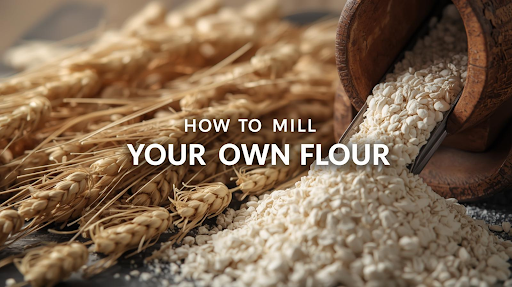Beginner’s Guide: How to Mill Your Own Flour at Home Easily
There’s a secret ingredient in the world’s most incredible bread, pasta, and pastries, and it’s not some rare spice or complex technique. It’s time. More specifically, it’s the fleeting moment after a grain of wheat is transformed and before its vibrant potential fades. This is the magic of fresh flour.
For centuries, flour was a local, living ingredient. Today, the bleached, all-purpose variety on supermarket shelves is a ghost of its former self—convenient, yes, but stripped of its nutrients, flavor, and soul. What if you could reclaim that? What if you could fill your kitchen with the warm, nutty aroma of grain freshly ground into powder?
Learning how to mill your own flour is a simple, profound step toward more nutritious and flavorful home baking. This guide will demystify the process, proving that anyone with a countertop and a few minutes to spare can become their own miller. Let’s dive in.
Why bother? The Compelling Case for Home-Milled Flour
Before we get into the mechanics of how to mill your own flour, it’s important to understand the why. The benefits extend far beyond simple novelty.
1. A Massive Nutritional Upgrade
This is the biggest draw for many. A whole grain of wheat is a nutritional powerhouse, containing the fiber-rich bran, the vitamin-packed germ, and Standard or Bob’s Red Mill. Choose organic if possible.
Step 2: Prepare Your Mill
Set up your mill on a clean, stable countertop. Place a bowl underneath the flour spout to catch your bounty. If your mill has adjustable settings, start with a medium-fine setting. You can always adjust later.the starchy endosperm. Commercial refined flour uses only the endosperm, discarding the most nutritious parts.
When you learn how to mill your own flour, you’re creating true 100% whole grain flour. But here’s the critical part: the natural oils in the germ are highly perishable. Once exposed by milling, they begin to oxidize and lose nutritional value. A study on wheat flour stability highlights that a significant loss of vitamins and antioxidants can occur within just days of milling. Freshly milled flour captures all its nutrients at their peak.
2. Unbeatable, Complex Flavor
Taste a pinch of store-bought whole wheat flour, then taste a pinch of flour you’ve just milled from hard red wheat berries. The difference is staggering. The fresh flour will have sweet, nutty, and almost creamy notes, while the store-bought version might taste bland or slightly bitter. This flavor translates directly into your baked goods, adding a depth you never knew was missing.
3. Total Control and Customization
When you mill your own, you control the variables. Want a super-fine flour for delicate pastries? A coarser grind for rustic bread? A unique blend of spelt, rye, and einkorn? You’re the master of your mill. This creative freedom is a huge part of the fun when you discover how to mill your own flour.
4. The Ultimate Kitchen Hack
Buying whole grains in bulk is often more economical than buying pre-packaged flour. Grains also have a much longer shelf life than flour, storing safely for years in airtight containers. You reduce waste and always have the base for flour on hand.
Also Read: How to Deal With Sudenzlase
The Essential Equipment: Choosing Your Mill

The cornerstone of learning how to mill your own flour is, of course, the mill itself. There are two primary types to consider.
Electric Grain Mills
These are the easiest and fastest option, perfect for baking large batches. You simply pour in the grains, turn it on, and collect the flour.
- Pros: Speed, consistency, ease of use. Great for families or avid bakers.
- Cons: Higher cost, requires counter space and electricity.
- Top Picks: The WonderMill is a fantastic electric grain mill known for its powerful motor and ability to produce very fine flour. Another highly-regarded option is the NutriMill.
Manual Grain Mills
These mills are operated by a hand crank, giving you a serious arm workout and a deep connection to the process. They are quiet, portable, and don’t require electricity.
- Pros: Affordable, great for small batches, provides independence, quiet operation.
- Cons: Labor-intensive, slower, can be difficult to achieve a very fine powder.
- Top Picks: The Country Living Grain Mill is a classic, durable manual mill, while the Back to the Basics Food Mill offers a more budget-friendly entry point.
Can I Use a Blender or Coffee Grinder?
A high-powered blender like a Vitamix or Blendtec can produce a coarse flour, but it will struggle to achieve the fine consistency needed for most baking. It also risks overheating the motor and the flour, which can damage nutrients. A dedicated grain mill is highly recommended for anyone serious about learning how to mill your own flour.
Your First Mill: A Step-by-Step Guide
Ready to try? The process is wonderfully straightforward. Here’s how to get started.
Step 1: Source Your Grains
Your flour is only as good as your grains. Look for “wheat berries” or other whole grains (like spelt, rye, or einkorn) from reputable sources. You can find them at health food stores, co-ops, or online from suppliers like Azure
Step 3: Mill!
For an electric mill, turn it on and slowly feed a small amount of grain into the hopper. Don’t overload it. For a manual mill, start cranking at a steady pace and add grains gradually. Listen to the sound—a steady, grinding hum means you’re on the right track.
Step 4: Sift (Optional)
After milling, you may want to sift your flour through a fine-mesh sieve. This removes any larger bran pieces, creating a lighter flour. Don’t throw the bran away! You can add it back in for more fiber or use it in other recipes.
Step 5: Use or Store
This is the most important step: use your flour quickly. For maximum nutritional benefit and flavor, try to use it within 24 hours. If you must store it, keep it in an airtight container in the refrigerator for a few days or the freezer for up to a month.
Fresh Flour Baking: Tips for Success
Baking with fresh flour is different from using store-bought. Here’s what you need to know.
- It’s thirsty: Freshly milled flour absorbs more liquid. When adapting a recipe, you’ll likely need to increase the hydration.
- Denser Results: The bran particles in whole grain flour can cut through gluten strands, leading to a denser loaf. Don’t expect the airy crumb of white bread. Embrace the hearty, satisfying texture.
- Start with Blends: Ease into it! Try replacing 25-50% of the store-bought flour in your favorite recipe with your home-milled flour. This helps you adjust to the differences without a baking fail.
Frequently Asked Questions
What’s the best grain for a beginner?
Hard white wheat is a fantastic starting point. It has a lighter color and milder flavor than traditional red wheat, making it versatile for everything from bread to cookies.
Is it really cost-effective?
Initially, the mill is an investment. However, buying organic wheat berries in bulk (e.g., a 25-50 lb bag) is significantly cheaper per pound than buying equivalent organic whole wheat flour. Over time, it pays for itself.
I have a gluten sensitivity. Can I still mill my own flour?
Absolutely. Many people with sensitivities to commercial wheat find they tolerate older varieties like Einkorn, Spelt, or Emmer much better. Learning how to mill your own flour allows you to experiment with these ancient grains at their freshest.
Conclusion: Rediscover the Heart of Baking
Learning how to mill your own flour is more than a kitchen skill; it’s a return to the roots of real food. It connects you to the ingredients in a fundamental way, turning a simple bag of grains into a world of possibility. The process of understanding how to mill your own flour is surprisingly simple, yet the rewards—the unparalleled aroma, the nutritional boost, the profound flavor—are immense.
Your journey to discover how to mill your own flour starts with a single grain. So, find a mill, grab a bag of wheat berries, and unlock the freshest, most flavorful chapter of your baking life yet.
Read More Like This: How to Fertile Chicken Eggs
Frequently Asked Questions
What’s the absolute best grain for a beginner to start with?
For your first time learning how to mill your own flour, we highly recommend Hard White Wheat Berries. They produce a whole wheat flour that is lighter in color and has a milder, sweeter flavor compared to traditional hard red wheat. This makes it incredibly versatile and an easy 1:1 substitution in most recipes that call for all-purpose or whole wheat flour, from sandwich bread to chocolate chip cookies. It’s the perfect gateway grain!
I’ve heard fresh flour can be tricky to bake with. What’s the biggest adjustment?
The single most important adjustment is hydration. Freshly milled flour is more absorbent because the bran particles are coarser and thirstier. If you use a recipe designed for store-bought flour, your dough will likely be too dry. The key is to add liquid gradually—a tablespoon or two at a time—until the dough reaches the soft, pliable consistency described in the recipe. Don’t be afraid to deviate from the written liquid amounts; trust the feel of the dough.
Is milling my own flour actually cost-effective?
It’s an investment that pays off. The initial cost of a quality mill is the biggest expense. However, buying organic wheat berries in bulk (e.g., a 25 or 50-pound bag) is significantly cheaper per pound than buying equivalent pre-packaged organic whole wheat flour. Over time, especially if you bake regularly, the savings on ingredients will offset the cost of the mill. You’re also paying for unparalleled quality and nutrition you can’t find in any store.
Can I use a high-powered blender instead of a dedicated grain mill?
While a powerful blender like a Vitamix or Blendtec can create a coarse meal or “flour,” it has significant limitations. Blenders are not designed for the sustained, fine grinding that a grain mill performs. They often struggle to achieve a fine enough consistency for delicate baking, can overheat the flour (damaging heat-sensitive nutrients), and risk burning out the motor. A dedicated mill is the right tool for the job if you’re serious about learning how to mill your own flour properly.
I have a sensitivity to modern wheat. Are there other grains I can mill?
Yes, Many people who struggle with commercial wheat find they tolerate ancient grains much better. When you control the mill, you can explore a world of options like:
- Einkorn: Known as the most ancient wheat, it has a different gluten structure that many find easier to digest.
- Spelt: A nutrient-dense grain with a mild, nutty flavor.
- Rye: Perfect for creating dense, flavorful breads.
- Gluten-Free Grains: You can also mill rice, oats, sorghum, and millet to create your own fresh, gluten-free flour blends.

